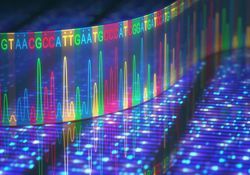Clinical Spatial Genomics: From Gene Lists to Genetic Maps
The innovative approach combines histopathology and genomics to create maps of genetic expression throughout a tissue
Histopathology and genomics represent two very different diagnostic approaches, but thanks to recent advances, the two have been combined to form what is known as spatial genomics, a technology now making its way into the clinic.
In histopathology, careful examination of a tissue sample can identify features that explain the cause of a patient’s disease. Genomics, on the other hand, usually relies on homogenizing tissue and sequencing its nucleic acids to determine the expression levels of each gene and the presence of deleterious mutations. While genomics can provide deep molecular insight into disease, this comes at the expense of the nuanced appreciation of tissue architecture that histopathology offers.
Spatial genomics involves technologies that profile gene expression while preserving information about where these genes are being expressed, in some cases with subcellular resolution. To underscore the importance of spatial genomics, consider the Human Cell Atlas project—an international endeavor to characterize the hundreds of cell types and subtypes in the human body to better understand the biology of health and disease. This ambitious project relies heavily on spatial genomics technologies to profile gene expression within intact tissue to create maps of where these cells are located in relation to one another.
Creating Spatial Genomic Maps
Using DNA probes
To create these maps, spatial genomics uses several methods. For example, sequential fluorescence in situ hybridization (seqFISH+) involves multiple rounds of FISH, which uses fluorescent DNA probes in conjunction with super-resolution microscopy, to detect the transcripts of over 10,000 different genes in tissue sections with subcellular resolution.
Developed at Stockholm University, a second method used in spatial genomics employs a longer DNA probe that hybridizes via its two ends to the targeted gene transcripts, looping into a ligated, circularized probe that includes a barcode. Sequencing of the barcode takes place within the tissue section under a microscope, hence its name, padlock in situ sequencing (ISS). By sequencing and identifying the barcode, one can determine which probe was at a particular location and by consequence, where in the tissue the targeted gene was expressed.
Spatial transcriptomics
Stockholm is also home to a second spatial genomics approach. Researchers at the Karolinska Institute and the Royal Institute of Technology have developed a method called spatial transcriptomics, where a histological section is placed on a slide printed with barcoded primers for reverse transcription. When gene transcripts leave the tissue section and hybridize to the barcoded primers beneath, complementary copies of the transcripts (cDNA) are synthesized then harvested, amplified, and sent for next-generation sequencing (NGS). Bioinformatic analysis then relocates each transcript to its original position in the tissue section by virtue of the individual barcodes that were integrated into the cDNA. Therefore, by leveraging the power of NGS, spatial transcriptomics produces a map of gene expression in a tissue.
A key strength of spatial transcriptomics is that it allows the detection of any expressed protein-coding gene in any species. On the other hand, probe-based approaches like padlock ISS and FISH-based methods are target- and species-specific. This leads to a bottleneck: combining too many probes to detect many different genes in one experiment dilutes each individual probe. Therefore, probe-based approaches are limited to detecting around 100 genes at a time.
FISH-based methods work around this bottleneck using repeated rounds of sequential imaging, which unfortunately extends the duration of any given experiment. This said, FISH-based approaches are superior to spatial transcriptomics in their cellular and subcellular resolution due to the dimensions of the barcoded primer spots. Initially, each printed spot with a given barcode spanned 100 microns and included between three to 30 cells. However, the latest generation of high-definition spatial transcriptomics arrays have barcoded spots of two microns, thereby approximating cellular resolution, though subcellular resolution remains out of reach.
Clinical applications of spatial genomics
Clinical applications of spatial genomics are in their infancy but are promising. For instance, tumor heterogeneity is a common feature of cancer where tumor subclones vary in their underlying genetic alterations, affecting the way they interact with their microenvironment. Spatial genomics can be used to investigate tumor microenvironment interactions by profiling gene expression of malignant, stromal, and immune cells while preserving the spatial relationships between them.
Two recent studies applied spatial transcriptomics to profile melanoma lymph node and pancreatic metastases. Both revealed a complex transcriptional landscape involving heterogenous malignant cells and their neighboring healthy cells. This level of analysis promises insights into the molecular mechanisms that underlie cancer pathogenesis as well as biomarkers that can aid in diagnosis and treatment.
While applying spatial transcriptomics requires well-equipped centralized laboratories, researchers have also developed a version of padlock ISS compatible with mobile phone microscopy. The researchers successfully used this method to detect rare KRAS mutant cells in a relatively cheap and decentralized approach to molecular diagnostics suitable for point-of-care settings. Notably, the same method is currently being developed for simple mobile COVID-19 detection.
Giving single-cell genomics a spatial context
Moreover, researchers are starting to combine different technologies, such as spatial transcriptomics and single-cell RNA sequencing: after dissociating the tissue and using single-cell genomics to group individual cells according to cell type, where a handful of genes can serve as markers for each group, spatial genomics can locate these cell types within intact tissue. This way, the cellular detail provided by single-cell genomics is given spatial context.
Similar to the difference between knowing how many clinics there are in a city and actually knowing where these clinics are located, genomic medicine is quickly moving from lists to maps. And as spatial genomics continues to increase in sensitivity and specificity and decrease in cost, the potential for clinical spatial genomics that infuses the nuance of histopathology with the detail of genomics may soon be realized.

